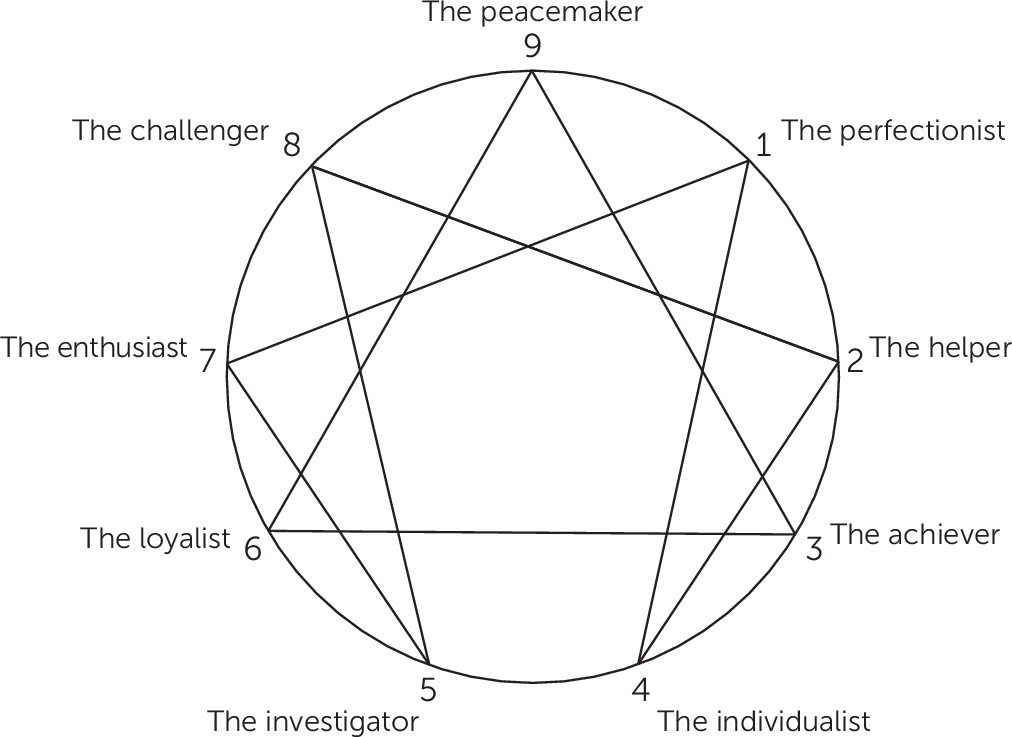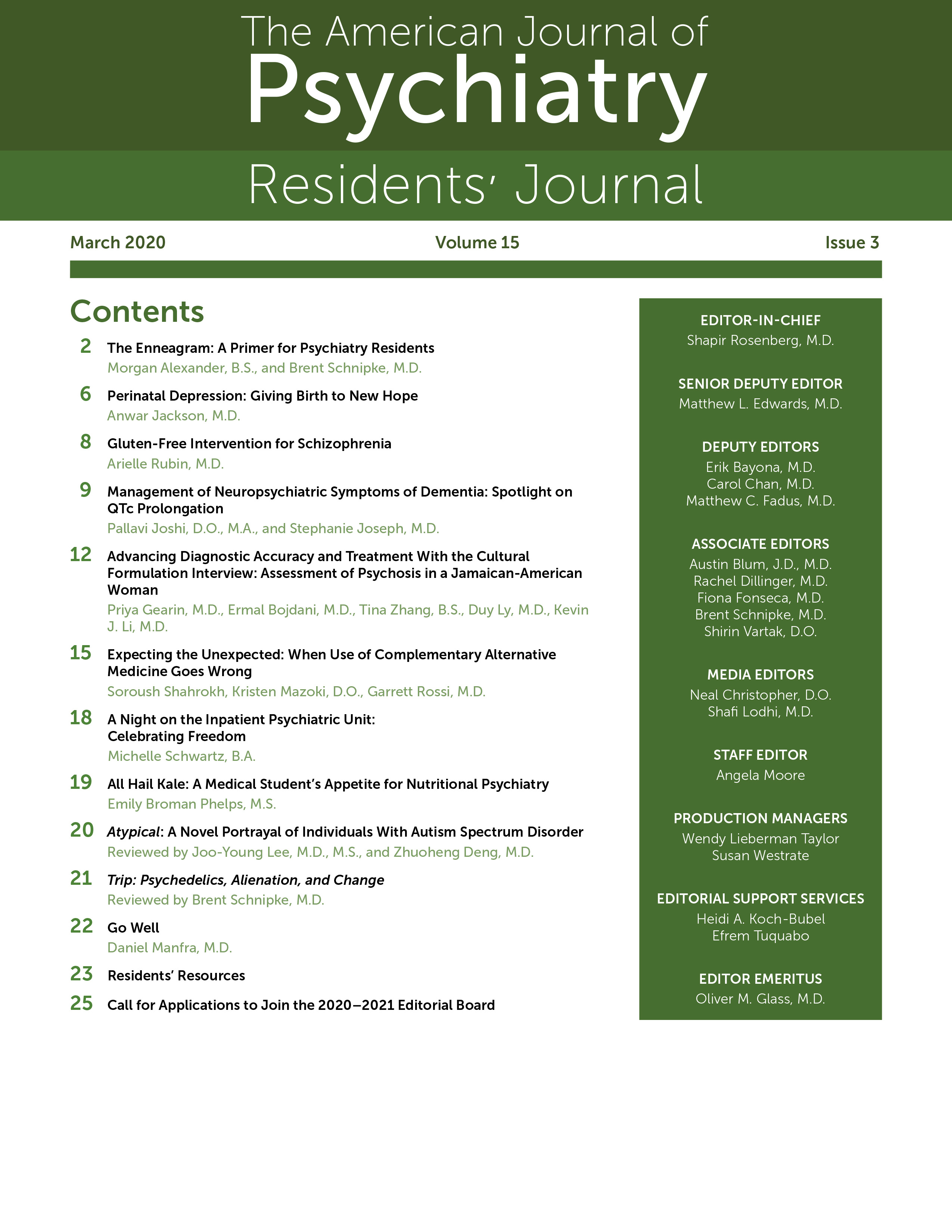The Enneagram: A Primer for Psychiatry Residents
Abstract
What Is the Enneagram?
History of the Enneagram in Psychiatry
Using the Enneagram: Features and Functions
| Type | Description | Basic fear | Basic desire |
|---|---|---|---|
| Type 1: the perfectionist | Principled, conscientious, organized, responsible, and committed. Concerned with improvement, morality, desire to perfect themselves and their surroundings. Seen as detail oriented, hypercritical, and judgmental. Struggle with an "inner critic," repressed anger, impatience, and a sense that nothing is good enough. | To be bad or corrupt | To be good or have integrity |
| Type 2: the helper | Intuitive, empathetic, people pleasing. Concerned with relationships and sense of connection to others. Seen as warm, emotional, comforting, optimistic, easy to flatter or manipulate. Struggle with advocating for their own needs and often "give to get"—working to meet the needs of others in hopes their needs will be met in return. | To be unworthy of being loved, to be unwanted | To be loved |
| Type 3: the achiever | Hard working, competitive, success oriented, and image conscious. Concerned with performance, external validation and praise, and feeling distinguished. Seen as self-assured, energetic, charming, focused on goals. Struggle with vulnerability and self-awareness of their own inner desires. | To be worthless or insignificant, to disappoint others | To be valuable and accepted |
| Type 4: the individualist | Sensitive, introspective, reserved, emotionally honest with self and others. Concerned with authenticity, able to endure suffering, and a tendency toward individualism and artistic expression. Seen as unique, creative, withdrawn, moody, self-absorbed. Struggle with a sense that something is lacking in themselves or the world. | To have no identity or personal significance | To be meaningful based on their inner experience |
| Type 5: the investigator | Cerebral, sensitive, independent, and emotionally restrained. Concerned with privacy, knowledge, insight, and contemplation. Seen as observant, expert, analytical, eccentric, and devoted to their group. Struggle with social interaction, emotional expression, and the tendency to isolate. | To be useless, helpless, or incapable | To be capable and competent |
| Type 6: the loyalist | Loyal, reliable, committed, security oriented. Concerned with clearly defined roles and structure, alliance to beliefs and groups. Seen as responsible, protective, anxious, suspicious. Struggle with fear, paranoia, worst-case scenarios. | To be without security and support | To have security and support |
| Type 7: the enthusiast | Enthusiastic, adventure seeking, optimistic. Concerned with freedom, excitement, and spontaneity. Seen as energetic, outgoing, the "life of the party." Struggle with compulsivity, overextension of self, and commitment. | To be confined or in pain | To be happy and satisfied |
| Type 8: the challenger | Willful, tough, and independent. Concerned with power dynamics, desire to be in control, and justice. Seen as a leader, hardworking, decisive, able to withstand conflict. Struggle with anger, fear of vulnerability, aggression. | To be harmed or controlled by others | To be in control and to protect self and others |
| Type 9: the peacemaker | Easygoing, open minded, peaceful, conflict avoidant. Concerned with harmony, comfort, boundaries. Seen as likeable, laid back, dependent, complacent. Struggle with finding their own voice and meaning, being passive aggressive or avoidant. | To be disconnected, separate, lost | To have peace and stability in their internal and external world |

| Instinctual variant | Features of focus |
|---|---|
| Self-preservation | Feeling safe, having material security, maintaining a sense of structure, avoiding danger, having enough resources |
| Social interaction | Cultivating relationships, giving and receiving attention, feeling recognized, getting along with the group, social standing |
| One-to-one (sexual) bonding | Developing interpersonal attraction, achieving and maintaining intimate connections, bonding |
Applications in Psychiatry
Conclusions
Key Points/Clinical Pearls
References
Information & Authors
Information
Published In
History
Authors
Metrics & Citations
Metrics
Citations
Export Citations
If you have the appropriate software installed, you can download article citation data to the citation manager of your choice. Simply select your manager software from the list below and click Download.
For more information or tips please see 'Downloading to a citation manager' in the Help menu.
View Options
View options
PDF/EPUB
View PDF/EPUBGet Access
Login options
Already a subscriber? Access your subscription through your login credentials or your institution for full access to this article.
Personal login Institutional Login Open Athens loginNot a subscriber?
PsychiatryOnline subscription options offer access to the DSM-5-TR® library, books, journals, CME, and patient resources. This all-in-one virtual library provides psychiatrists and mental health professionals with key resources for diagnosis, treatment, research, and professional development.
Need more help? PsychiatryOnline Customer Service may be reached by emailing [email protected] or by calling 800-368-5777 (in the U.S.) or 703-907-7322 (outside the U.S.).
